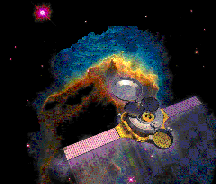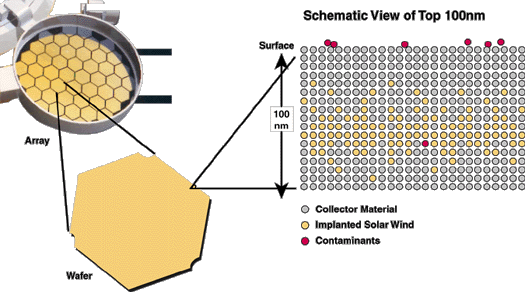What's this thing called solar wind?
 Solar
wind is a stream of particles emitted continually from the
sun. Solar wind moves very fast at roughly 400 kilometers
per second (about 1 million miles per hour). It will hit the
Genesis spacecraft and push through the surface. Pieces of
the sun will be trapped inside the Genesis spacecraft--not
inside like in a can. Inside meaning inside the material of
the spacecraft. The spacecraft is made of super clean stuff,
so the scientists will know that anything that is more than
what went out into space must be pieces of the sun. Shown
below is an image (up-close) of what trapped material from
the sun will look like when it is collected. Solar
wind is a stream of particles emitted continually from the
sun. Solar wind moves very fast at roughly 400 kilometers
per second (about 1 million miles per hour). It will hit the
Genesis spacecraft and push through the surface. Pieces of
the sun will be trapped inside the Genesis spacecraft--not
inside like in a can. Inside meaning inside the material of
the spacecraft. The spacecraft is made of super clean stuff,
so the scientists will know that anything that is more than
what went out into space must be pieces of the sun. Shown
below is an image (up-close) of what trapped material from
the sun will look like when it is collected.

 Is
Genesis the first mission to study solar wind? Is
Genesis the first mission to study solar wind?
Many
space missions have contributed to our current understanding
of solar wind:
In the
1960s and 1970s, there was a series of spacecraft with names
such as IMP (Interplanetary Monitoring Platform), Pioneer,
and ISEE (International Sun-Earth Explorer) that measured
many of the properties of the solar wind.
The Apollo
missions (11, 12, 14, 15, 16, and 17) to the moon in the 1970s
used simple foil collection devices to trap solar wind particles
for analysis back on Earth. Chemists studying these samples
determined the abundances of a few elements in the solar wind
at the surface of the moon.
The space
station Skylab found the origin of the fast solar wind in
1973-1974.
The joint
European-NASA spacecraft Ulysses orbited the sun from South
to North in 1994-1995, confirming the existence of fast solar
wind coming out of the sun's poles.
The Japanese
spacecraft Yohkoh observes the sun's corona for information
about the escape of solar wind particles.
The International
Solar-Terrestrial Physics Initiative (ISTP) included several
spacecraft and a multitude of detection instruments. Japans'
Geotail (1992, carrying 2 US instruments), NASA's WIND
(1994, carrying French and Russian detectors), ESA/NASA's
SOHO (1995), Russia's Interball (1995), and NASA's
Polar spacecraft (1996), were all part of the international
effort to understand solar wind.
The IMAGE
spacecraft showed global pictures of the Earth's magnetosphere
responding to changes in the solar wind. The ACE spacecraft
measures the intensity of solar wind. It provides about an
hour's warning of extreme solar wind, "storms"
that could overload power grids, disrupt satellite communications,
and potentially harm astronauts.
|
